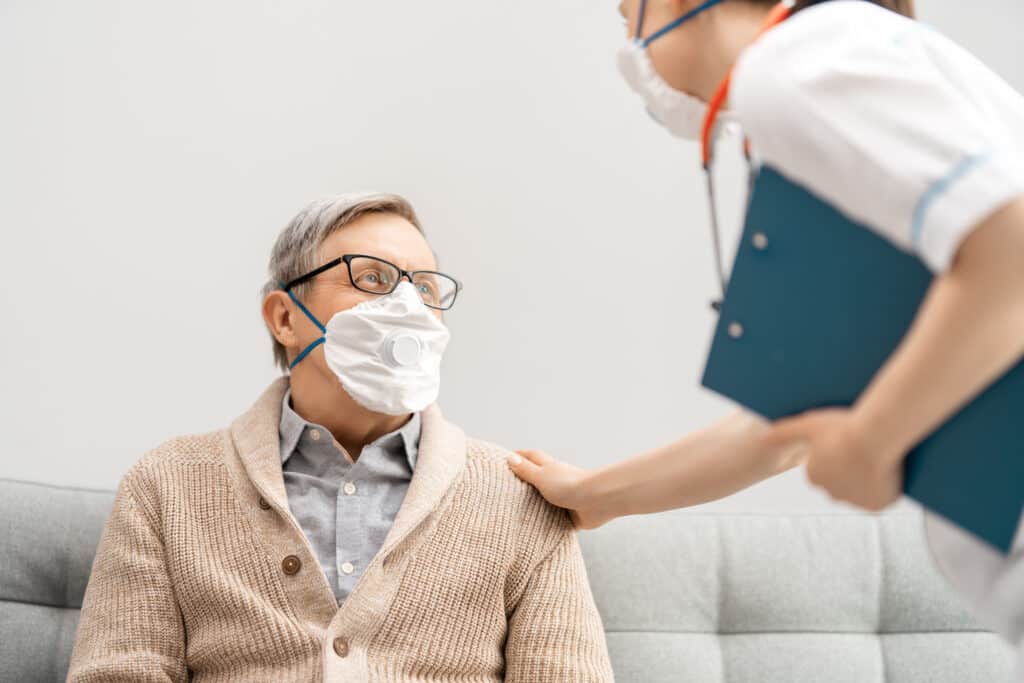Have you ever experienced a sensation where it seems like the room is spinning around you, or you’re moving when you’re stationary?
This unsettling feeling is known as vertigo, which is not a disease but a symptom of various conditions that affect your inner ear or brain’s balance system. Vertigo can lead to feelings of dizziness, nausea, or instability, disrupting your daily routine and diminishing your quality of life.
While there are numerous causes of vertigo, such as ear infections or head injuries, a surprising and recently discovered cause is COVID-19. Despite the pandemic’s many established dangers, vertigo has become a significant concern for many older adults.
As a physical therapist, I have worked with many patients who have experienced vertigo while recovering and who have experienced dizziness as a symptom of COVID-19. Understanding the link between vertigo and the virus is crucial for older adults to avoid the pitfalls of this condition.
In this article, I will provide insights into how frequently vertigo occurs among COVID-19 patients. We’ll also examine its duration, symptoms, and effective management strategies that you may want to consider.
How Common is Vertigo in COVID-19 Patients?

Vertigo, a sensation of feeling off balance, is associated with COVID-19 more frequently than you may realize. Numerous studies have delved into the prevalence of vertigo among COVID patients, providing helpful data.
A 2021 report by the American Academy of Otolaryngology-Head and Neck Surgery (AAO-HNS) revealed that over 30 percent of hospitalized COVID-19 patients experienced symptoms of dizziness, with 6 percent suffering from true vertigo. This indicates that nearly one in three coronavirus patients experienced dizziness or a related symptom.1
Further research in 2022 reviewed several studies and found a prevalence rate of up to 20% for dizziness and up to 12% for vertigo. This suggests that vertigo is not a rare symptom.2
These figures strongly indicate that vertigo is a relatively common symptom of COVID-19. However, it may infrequently be recognized or reported for several reasons.
Primarily, the diagnosis and treatment of COVID-19 have mainly been focused on respiratory symptoms such as cough, fever, shortness of breath, or loss of smell and taste. These symptoms are more apparent and are more likely to lead individuals to seek medical attention.
Secondly, neurological symptoms of COVID-19, like vertigo, headaches, confusion, or loss of consciousness, are more complex to diagnose. This is mainly because these symptoms can often be attributed to other factors such as dehydration, stress, anxiety, or side effects of medication.
In my clinical practice, I’ve observed that one of the most prevalent forms of vertigo is Benign Paroxysmal Positional Vertigo (BPPV). This condition is caused by the displacement of crystals in the inner ear, leading to spinning sensations, loss of balance, and nausea.3
Given these findings, it’s crucial to be aware of the potential for vertigo as a symptom of COVID-19. Monitoring your balance and hearing is wise if you’ve contracted the virus.
The Duration of Vertigo Post COVID-19
If you’ve been grappling with vertigo during or after your bout with COVID-19, you’re likely wondering about its duration and if it will resolve itself. The answer, however, isn’t straightforward and depends on multiple factors.
How Long Will My Vertigo Last?
The duration of vertigo post-COVID-19 varies significantly among individuals. Some may experience it for a few days or weeks, while others may grapple with it for months or even longer.
The frequency and severity of vertigo episodes also differ, with some experiencing mild or occasional bouts. In contrast, others suffer severe or frequent attacks that hinder their daily activities.
As a healthcare professional, I’ve worked with numerous patients recovering from COVID-19 who have experienced vertigo. The duration and intensity of their symptoms have varied widely. Predicting the course of vertigo symptoms is challenging due to our limited understanding of the COVID-19 virus, much like other symptoms such as loss of taste or smell.
Vertigo may be more intense or prolonged after COVID-19 than other viral infections because the virus can cause significant irritation to the inner ear or nerve tissues involved in balance and hearing.
Additionally, COVID-19 can trigger or exacerbate conditions that lead to vertigo, such as post-COVID syndrome (long COVID), vestibular migraines, or Meniere’s disease.
The Relationship Between Long CoVID and Vertigo
Post-COVID syndrome, also known as long COVID, refers to persistent symptoms experienced by some individuals after recovering from COVID-19. These symptoms can include fatigue, brain fog, shortness of breath, chest pain, palpitations, anxiety, depression, and vertigo. While the exact cause of post-COVID syndrome remains unclear, it may be linked to inflammation, immune system dysfunction, or organ damage caused by the virus.
Vestibular migraines are a type of migraine that can cause vertigo, along with headaches, nausea, sensitivity to light and sound, and vision problems.
Stress, hormonal changes, dehydration, certain foods, or medications can trigger these migraines. Some individuals who have had COVID-19 may develop vestibular migraines for the first time or experience more frequent or severe episodes.
Meniere’s disease is an inner ear disorder that results in episodes of vertigo, hearing loss, tinnitus (ringing in the ear), and a feeling of fullness in the ear.
It can be caused by fluid buildup in the inner ear, infection, inflammation, or trauma. Some individuals with COVID-19 may develop Meniere’s disease or experience worsening symptoms.
If you’re dealing with persistent or disabling vertigo symptoms post-COVID, it’s crucial to consult your doctor. If diagnosed with BPPV, you may be referred to an ear, nose, and throat specialist or a physical therapist for treatment.
Common Symptoms Accompanying Post-COVID Vertigo

CoVID-related vertigo can be associated with various symptoms impacting your physical and mental health. These symptoms can differ based on the course of COVID-19 and the type of vertigo experienced. Here are some of the most frequently reported symptoms
Nausea, Vomiting & Headache
These are common symptoms of motion sickness, which can occur when the brain receives conflicting signals about your position and movement from your eyes, ears, and body. Vertigo can induce nausea and vomiting by creating discrepancies between what you see and feel.
Migraine headaches, which can sometimes lead to vertigo, are often characterized by throbbing, pulsating, or stabbing pain. They can affect one or both sides of the head. They may be accompanied by sensitivity to light and sound, visual disturbances, or an “aura” in your visual field — a warning sign of an impending migraine.
Hearing Loss
Inner ear disorders such as vestibular neuritis, labyrinthitis, or Meniere’s disease can cause vertigo and lead to hearing loss.
This loss can be sudden or gradual, partial or complete, temporary or permanent, and affect one or both ears. Accompanying symptoms may include tinnitus (ringing in the ear), a feeling of fullness in the ear, or ear pain.
Imbalance & Difficulty Walking
Vertigo can impact your balance system, leading to feelings of swaying, tilting, or falling. You may have trouble maintaining your balance or walking in a straight line, increasing your risk of stumbling, tripping, or falling and potentially leading to injury.
Fatigue
Post-COVID syndrome, also known as long COVID, can sometimes cause vertigo and is often accompanied by fatigue.
This can include extreme tiredness, weakness, or exhaustion that does not improve with rest or sleep and can impact your physical and mental performance, mood, and motivation.
Brain Fog
Another common symptom of long COVID, brain fog, can accompany vertigo. This term describes cognitive impairment, such as difficulty concentrating, remembering, thinking clearly, or making decisions. It can also affect your speech, language, or communication skills.
Anxiety or Depression
Vertigo and its associated symptoms can lead to psychological effects such as anxiety and depression. The feelings of helplessness, hopelessness, or isolation caused by vertigo can trigger these conditions.
Additionally, anxiety and depression can exacerbate dizziness by increasing stress levels, affecting sleep quality, or reducing coping skills.
In our clinical experience, patients recovering from COVID-19 or experiencing post-COVID symptoms often benefit most from a focus on self-care, a gradual increase in physical activity, and close communication with their physician about any changes in symptoms such as vertigo.
Practical Tips and Strategies for Managing Vertigo
While there isn’t a universal remedy for managing vertigo, several practical strategies can help you alleviate the symptoms associated with this condition.
Hydration and Balanced Blood Sugar Levels are Key
Staying hydrated and maintaining balanced blood sugar levels are essential in managing vertigo. Dehydration and hypoglycemia, or low blood sugar, can exacerbate the symptoms of vertigo.
These conditions can affect your blood pressure, blood flow, and brain function, leading to heightened feelings of dizziness.
To prevent this, ensure you are drinking an adequate amount of water and consuming regular meals. Opt for foods rich in complex carbohydrates, such as sweet potatoes or whole grains, and fiber.
Move Slowly and Avoid Sudden Position Changes
Quick or sudden movements can trigger or worsen vertigo attacks. Rapid position changes are jarring to the balance system in your inner ear or brain. If you’re experiencing vertigo symptoms, moving slowly and cautiously is advisable.
This is particularly important when transitioning from lying down to standing or turning your head. Consider using pillows or cushions to elevate your head when lying down or sleeping to avoid lying completely flat.
Consider Using Assistive Devices
If you’re struggling with balance due to vertigo, consider using assistive devices like a cane or walker. These tools can provide stability and help prevent falls.
As a health educator, I often advise older adult patients to wear supportive shoes for safety, particularly when using assistive devices.
Avoid Driving or Operating Heavy Machinery
Avoid driving or operating heavy machinery if you’re experiencing significant vertigo symptoms. Vertigo can affect your vision, judgment, reaction time, and concentration, increasing your risk of accidents and injuries.
When To Consult Your Doctor

If you’re experiencing persistent or disabling vertigo following a bout of COVID, it’s essential to speak with your doctor. They can help identify the root cause of your vertigo and guide you toward the most effective treatment. Here are some potential treatment options your doctor may suggest:
Medication: In some cases, your doctor may prescribe medication to alleviate inflammation, nausea, or anxiety that could be contributing to your vertigo symptoms.
Vestibular Rehabilitation Therapy: This specialized form of physical therapy involves exercises designed to improve your balance and reduce your sensitivity to motion. It’s particularly effective in helping your brain adapt to inner ear or nerve function changes due to COVID.
Canalith Repositioning: If your vertigo is due to displacement of these tiny components in your inner ear — a condition previously referred to as BPPV— your physical therapist or ear, nose, and throat doctor may utilize head positioning techniques to help restore normal function.
Remember, it’s crucial to consult with your healthcare provider to determine the best course of action for your specific situation. They can provide a proper diagnosis and treatment plan tailored to your needs.
Key Takeaways
- Vertigo, a sensation of feeling off balance, is a relatively common symptom of COVID-19, affecting up to 30% of hospitalized patients.
- The duration of vertigo post-COVID-19 varies significantly among individuals, with some experiencing it for a few days or weeks while others may grapple with it for months or even longer.
- COVID-related vertigo is associated with symptoms such as nausea, vomiting, headaches, hearing loss, imbalance, difficulty walking, fatigue, brain fog, anxiety, and depression.
- Staying hydrated, maintaining balanced blood sugar levels, moving slowly, avoiding sudden position changes, using assistive devices, and avoiding driving or operating heavy machinery can help manage vertigo symptoms.
- If experiencing persistent or disabling vertigo following a bout of COVID, it’s important to consult a doctor. Treatment options may include medication, vestibular rehabilitation therapy, or canalith repositioning.
References
- Özçelik Korkmaz M, Eğilmez OK, Özçelik MA, Güven M. Otolaryngological manifestations of hospitalized patients with confirmed COVID-19 infection. Eur Arch Otorhinolaryngol. 2021 May;278(5):1675-1685. doi: 10.1007/s00405-020-06396-8. Epub 2020 Oct 3. PMID: 33011957; PMCID: PMC7532931.
- Korres G, Kitsos DK, Kaski D, Tsogka A, Giannopoulos S, Giannopapas V, Sideris G, Tyrellis G, Voumvourakis K. The Prevalence of Dizziness and Vertigo in COVID-19 Patients: A Systematic Review. Brain Sci. 2022 Jul 20;12(7):948. doi: 10.3390/brainsci12070948. PMID: 35884754; PMCID: PMC9313303.
- Balatsouras DG, Koukoutsis G, Fassolis A, Moukos A, Apris A. Benign paroxysmal positional vertigo in the elderly: current insights. Clin Interv Aging. 2018 Nov 5;13:2251-2266. doi: 10.2147/CIA.S144134. PMID: 30464434; PMCID: PMC6223343.





